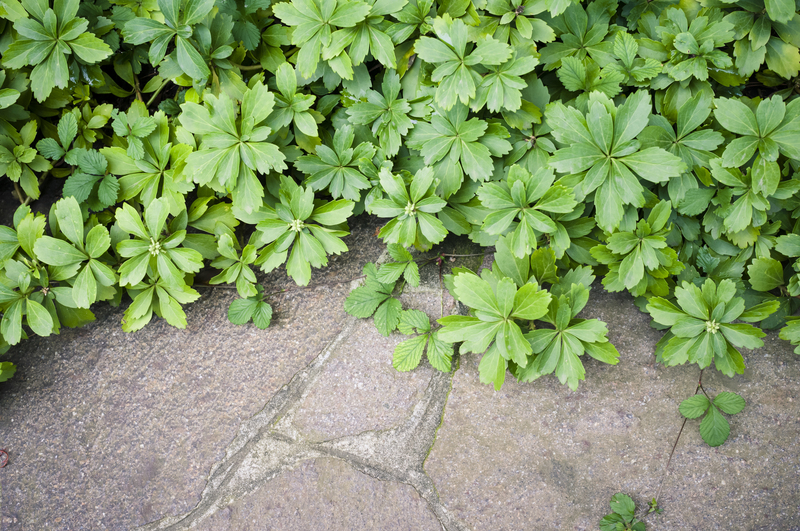Cultivate a garden that's safe and fun for dogs
Posted on 10/09/2025
Cultivating a Garden That's Safe and Fun for Dogs
A beautiful garden can be the heart of a home--a place for relaxation, creativity, and connection with nature. But for dog owners, planting a garden that's both safe and enjoyable for their furry companions requires extra planning and consideration. This comprehensive guide will show you how to cultivate a garden that's dog-friendly, safe, and fun for the entire family.

Why Create a Dog-Safe and Fun Garden?
A dog-friendly garden isn't just about preventing accidents; it's about enhancing your pet's life while maintaining a lush and enjoyable outdoor space for everyone. From engaging your dog's senses with textures and scents to building pathways for exercise and removing potential hazards, a little foresight can prevent many common problems and turn your yard into your dog's favorite place to be.
- Encourages exercise and outdoor play
- Stimulates mental and physical health for dogs
- Reduces destructive behaviors indoors
- Provides peace of mind for pet parents
If you want to cultivate a pet-safe garden that is also visually stunning, read on for practical tips, plant recommendations, design ideas, and safety precautions.
Essential Steps to Create a Dog-Friendly Garden
1. Assess Your Garden Space
Start by walking around your yard. Identify existing hazards, vulnerable garden beds, open access points, and potential play zones. Consider your dog's habits: do they love to run, dig, or sunbathe? Understanding these elements will help you plan a more dog-safe and fun outdoor area for dogs.
2. Choose Non-Toxic, Pet-Safe Plants
Not all beautiful flowers and shrubs are safe for pets. Many common garden plants can be harmful or toxic to dogs if ingested. It's important to select dog-safe plants for your landscape.
- Dog-friendly flowers: Sunflowers, Roses (thornless varieties), Marigolds, Snapdragons, Camellias
- Non-toxic herbs: Basil, Sage, Thyme, Parsley, Rosemary
- Safe grasses and ground covers: Buffalo grass, Bermuda grass, Clover, Alyssum, Creeping thyme
Avoid these common toxic plants: Sago Palm, Azaleas, Oleander, Foxglove, Daffodils, Tulips, Lilies, Hostas.
For a more detailed list, check the ASPCA's Toxic and Non-Toxic Plant Guide.
3. Designate Play and Activity Zones
A clever way to cultivate a fun garden for dogs is by creating designated areas for them to play, run, and explore. This not only protects your delicate flower beds but also gives your pet a sense of territory.
- Dig pit: Set up a corner filled with loose soil or sand, bury toys occasionally to encourage digging there instead of your flower beds.
- Obstacle course: Use tunnels, low jumps, or agility poles for exercise and mental stimulation.
- Fetch space: Maintain a clear, grassy open area for running and playing fetch.
- Wading pool: Provide a shallow splash pool for cooling down on hot days.
4. Ensure Safe Fencing
One of the most important factors in creating a safe garden for dogs is secure fencing. Choose fencing that is tall enough and without gaps. For small breeds or diggers, consider burying chicken wire or installing a hard barrier a few inches below the surface to prevent escapes.
- Regularly inspect fences for damages or holes.
- Choose materials that can't be chewed through easily.
- Avoid sharp edges or points.
5. Create Cool, Shaded Retreats
Dogs can overheat quickly in direct sun. Be sure to provide shaded spots with trees, shrubs, pergolas, or doghouses. Vines like grapevine or wisteria (if non-toxic in your region) can cover arbors for cool resting spaces.
6. Select Dog-Proof Mulch and Ground Covers
Certain mulches, such as cocoa mulch, are toxic for dogs. Instead, choose safe alternatives like:
- Pine, cedar, or cypress mulch
- Pea gravel or river rocks (ensure large enough not to swallow)
- Artificial turf (dog-specific types are durable and easy to clean)
7. Water Features and Drinking Stations
Dogs love to splash and drink outdoors. A small, shallow pond or a circulating fountain adds fun and beauty. However, make sure water features are clean, chemical-free, and easily accessible. Always supervise swimming or wading to prevent accidents.
- Use pet-safe aquatic plants
- Avoid algaecides and toxic pond chemicals
- Change water regularly
Dangerous Hazards to Avoid in a Dog Garden
1. Toxic Landscaping Materials
- Cocoa mulch: Contains theobromine, toxic to dogs.
- Fertilizers and pesticides: Many are unsafe; opt for organic, pet-safe options when possible.
- Insecticides and slug pellets: Deadly to pets and wildlife.
2. Sharp Tools and Garden Equipment
- Store tools securely in a shed or a locked box.
- Remove garden stakes, wire cages, and other sharp objects after use.
3. Compost and Garden Waste
- Mold and certain food scraps can be highly toxic if ingested.
- Keep compost piles fenced or lidded.
4. Harmful Wildlife and Insects
- Identify and control pests such as ticks, fleas, and toxic toads.
- Prevent access to standing water where mosquitoes breed.
Enriching Your Dog's Garden Experience
1. Sensory Gardens for Canines
Dogs experience the world through their senses, especially smell and touch. Incorporate elements in your dog garden that appeal to these senses:
- Herb gardens: Plant lavender, mint, or basil. Dogs enjoy sniffing (but don't plant too much mint--it can spread aggressively).
- Diverse textures: Mix smooth stones, soft grasses, sand, and bark for a tactile playground.
2. Pathways and Trails
Dogs love exploring. Use winding paths made of flagstone, mulch, or gravel to channel movement and protect delicate planting beds. Paths also help both dogs and humans navigate the garden without getting muddy paws or shoes.
- Create a "doggy highway" along the fence perimeter--many dogs love to patrol their territory.
3. DIY Dog Toys and Features
- Tire tunnels and steps: Repurpose old tires as agility structures.
- Water features: Install a splash pad or hose attachment for play.
- Buried toys: Occasionally bury favorite toys in the dig pit to encourage good digging behavior.
- Scent games: Hide treats or food puzzles under safe shrubs for mental stimulation.
Low-Maintenance Dog-Safe Landscaping Ideas
1. Raised Beds and Planters
Protect delicate or edible plants by growing them in raised beds or containers out of reach of playful pups. Choose tall planters or install protective fencing around vegetable patches.
2. Hardy Groundcovers
- Creeping thyme and clover: Tolerate foot traffic and sniffing while being non-toxic.
- Artificial turf: For neatness and ease of cleanup, consider pet-specific synthetic grasses.
3. Easy-Clean Surfaces
Stone pavers, brick pathways, and gravel are all easy to hose down and keep sanitary. These materials are tough, non-toxic, and comfortable for dogs' paws.
Training Tips for a Dog-Friendly Garden
It's easier to cultivate a garden that's safe and enjoyable for dogs if your pet knows the house rules:
- Lead by example: Walk your dog along paths, not through garden beds.
- Reward good behavior: Treats or praise for using designated potty and play areas.
- Discourage digging: Guide your dog to their dig pit and reward using it.
- Redirect destructive behaviors: Offer chew toys and games outdoors.
Routine Maintenance and Safety Checks
- Inspect for toxic mushrooms, sharp debris, or wildlife regularly.
- Reseed bare patches and repair fencing as needed.
- Use only pet-safe insecticides and fertilizers.
- Regularly scoop waste and thoroughly clean water features.
- Watch for signs of plant consumption or unusual pet behavior.
Inspiring Dog-Safe Garden Designs
Need inspiration to help create a garden that's safe and fun for dogs? Consider these ideas:
- Cottage-style garden: Mix wildflowers with sturdy perennials and create cozy nooks.
- Japanese-inspired: Smooth stepping stones, raked pebbles, and bamboo screens for peace and play.
- Modern minimalism: Easy-clean synthetic turf, raised planters, and agility equipment.
- Edible gardens: Safe veggies (carrots, peas, beans), fruit trees with fencing, and herb spiral beds.

Common Questions About Dog-Safe Gardens
What should I avoid planting in a dog garden?
Any plant listed as toxic to dogs by organizations like the ASPCA. Avoid popular blooms such as lilies, tulips, and sago palm.
Is mulch safe for dogs?
Avoid cocoa mulch entirely. Choose pine, cedar, or cypress mulch, and ensure dogs don't eat large amounts.
What is the best surface for a dog-friendly yard?
Tough, non-toxic grasses, artificial turf, and smooth gravel work well. Avoid sharp stones and spiky plants.
How do I keep my dog from digging up my plants?
Provide a dedicated dig zone, fence prized plants, and reward your dog for digging only in approved areas.
Conclusion: Cultivating a Garden That's Safe and Fun for Dogs
With thoughtful planning, a keen eye for pet-safe plants, and a few creative touches, you can cultivate a garden that's safe and fun for dogs without sacrificing beauty or utility. You'll nurture your garden--and your bond with your canine companion--by providing a space that celebrates nature, safety, and joy. Get started today, and watch as your backyard becomes both a sanctuary and a playground for your best friend!
For more tips on pet-safe gardening, subscribe to our newsletter or visit your local garden center for expert advice tailored to your area.



